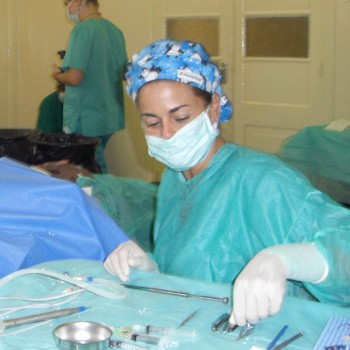You started your collaborations with Eyes of the world in 2003. How did you get to know the Foundation? What encouraged you to participate in the commissions?
I met Eyes of the world through Dr. Carlos Moser. He collaborated with the Foundation and encouraged me to participate in an expedition he was preparing. I accepted without really knowing what I was going to do there, but I wanted to live that experience.
You have traveled several times to Mozambique, where Eyes of the world carries out his solidarity work. What moves you to get so involved?
I always say the same when people ask this question, either you like it or you do not like it; I have fallen in love with Africa thanks to this experience. To know that you can help people, it makes you feel very good.
What has impressed you most in all this time?
When I arrived in Inhambane the first time, everything shocked me, the people, how they came to the hospital, the stories behind every case, the staff that helped us, the reactions of many patients when we removed the ocular dressings the day after the surgery, the hospital itself, the city, in short everything. Even today some things impress me, despite having seen them many times.
How was the last solidary experience with Eyes of the world as a member of the commission that has traveled to Inhambane?
Each experience is unique and different. On this occasion, the primary objective was the training of the local staff; therefore, we all thought that it would be a quieter commission, but in the end, we were swamped as always.
What is your assessment of the commission?
A 10; the five participants of the commission we worked together as a team, that is important for the proper functioning of the group. I want to make a special mention to my colleague the nurse Miriam Martín, her entirely voluntary and altruistic way has accompanied us, without her I could not have done it.
What was the work carried out by the local professionals during the commission? Did you find a good predisposition on their part?
The local professionals have pleasantly surprised me, perhaps it was the year they gave more of themselves, especially Katerine, the instrumentalist who manifested all the time predisposition and interest in learning. Personally, it’s what I’m keeping. Hopefully, they will continue practicing what we’ve tried to teach them. We have placed particular emphasis on care, handling, cleaning, and instrumental sterilization.
Describe us Mozambique and its people with few words
Mozambique is color: the green of its vegetation, the orange of the ground and the blue of the sea. Mozambique is its people: cheerful, friendly and grateful.
What difference did you find regarding the first time you traveled with Eyes of the world in Mozambique?
Every year I have seen an advance in many aspects. I think the country has improved economically. What I would like to highlight is the positive evolution of the functioning of the ophthalmological operating room within the possibilities that they have, and that thanks to Eyes of the world there is already a Mozambican ophthalmologist there. From my point of view, this is what it is about, to give a training so that they can fend for themselves.
In your opinión, what adds professionally the work you perform at the foundation?
From the professional point of view, it is an experience that I could not carry out here, I have learned to value the resources we have. I have learned to live 24 hours with professionals who despite working long and hard kept the good vibes making possible for all of us to get along.
And at the personal level, what would you say you have learned thanks to Eyes of the world?
I have learned to appreciate the material in its proper measure. We can live with less and we can be happy with little.
I would not like to forget to mention essential people who accompany me throughout this adventure, especially my colleagues and friends Laura Díaz, Esther Vilalta and Miriam Martín.
